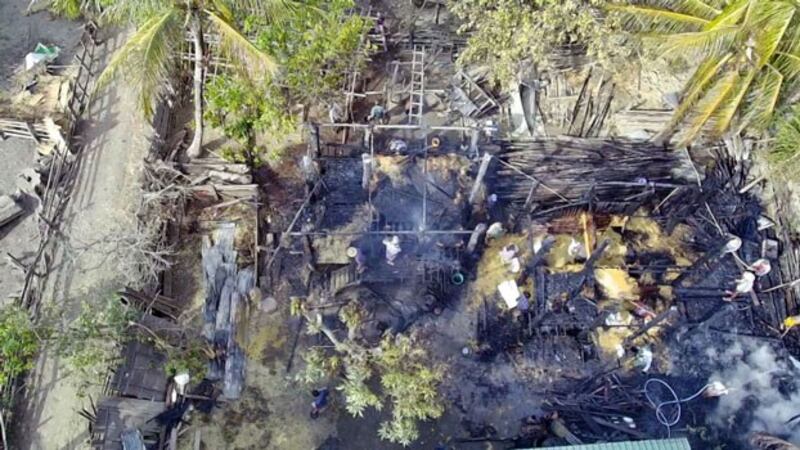More than 400 civilians clustered in four townships in northwestern Myanmar’s Sagaing region have been killed over the past two years by airstrikes, artillery fire, landmines and murder by junta troops, according to data compiled by Radio Free Asia.
Sagaing emerged early on as a hotbed of armed resistance following the military’s takeover in a February 2021 coup d'état and has remained so nearly three years later with armed conflicts occurring almost every day between rebels groups and junta troops.
Breaking down the four townships, some 265 people were killed in Kanbalu, 51 in Katha, 44 in Tigyaing and 33 in Indaw, information from witnesses, locals, and media releases by rights groups and resistance groups indicated.
The largest death toll came during an April 2023 aerial attack on Kanbalu’s Pa Zi Gyi village.
In the past three months, fierce fighting between local People’s Defense Forces and junta soldiers has erupted in Tigyaing.
The Tigyaing Revolution Force, an armed resistance group, announced on Dec. 22 that the junta had conducted at least 150 airstrikes in the area.
Three people were killed by airstrikes on Jan. 3, said a member of the Tigyaing People's Defense Force who did not want to be named.
“They attacked the civilians’ homes, [and] three homes were destroyed,” he told RFA. “Three civilians were killed, and four were injured. From the very beginning, almost 30 people have been killed by airstrikes.”
Intensifying violence
In Kanbalu township, before the Pa Zi Gyi village incident, junta soldiers abducted and killed 14 civilians in 2022, and torched about 500 houses in Kyi Su village, killing 10 local residents last July 18 and 19, said a resident, who did not want to be named for fear of his safety.
“People lost their lives in various ways,” he said. “The worst situation was in November 2022 when there was a mass killing of 14 people in Koe Taung Boet village tract. It was the worst incident apart from the air attack.”
An official from the Katha township People's Defense Force, or PDF, who declined to be named for the same reason, said clashes with junta troops intensified in the second half of 2023, as the number of resistance forces in the area increased.
“So, they [the junta troops] burned more houses and killed more people,” he said. “In 2023, people could be killed on sight.”

Seven residents were killed, and more than 30 were wounded when two junta fighter jets dropped bombs on Katha’s Moe Dar Gyi village after a Buddhist novitiation ceremony — a coming-of-age rite for boys under 20 who are joining a monastery — on Jan. 18, 2023.
Then on Sept. 17 of last year, seven civilians from Toke Gyi village in Katha township were arrested and killed by junta soldiers.
Junta troops also captured and shot dead villagers in Indaw township, whom they accused of having ties to PDFs, said an official from the Indaw PDF.
“In Kyaung Kone [village], they saw something on their phones while they were checking and beat them to death,” he said. “A group of eight people were also killed because they were relatives of PDF members.”
Worst violence
Kyaw Zaw, spokesman for the President’s Office of the shadow National Unity Government, confirmed that the most civilian killings occurred in Sagaing region.
“Mass killings occurred all over Myanmar, and the most incidents took place in Sagaing,” he said.
“After the start of Operation 1027, the terrorist junta increased attacks on civilians,” he added, referring to a series of simultaneous attacks by an alliance of three ethnic armies that began last Oct. 27 in multiple towns in northern Shan state.
Sai Naing Naing Kyaw, Sagaing region’s ethnic affairs minister and junta spokesman, told RFA that he could not comment on the situation because he was traveling.
The junta is oppressing civilians more and more to maintain power, said a spokesman for Kachin Human Rights Watch, who asked to be identified only by his first name Jacobfor fear of being arrested by junta soldiers.
“Currently, civilians are being killed unjustly in Sagaing region,” he told RFA. “This is a violation of human rights.”
Translated by Htin Aung Kyaw for RFA Burmese. Edited by Roseanne Gerin and Malcom Foster.

